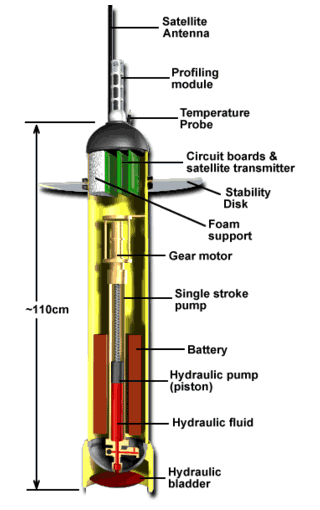Technology
The modern array consists mainly of PROVOR (Ifremer, Kannad), APEX (Webb Research Corporation) and SOLO (Scripps) floats, new generation floats ARVOR (descendent of the PROVOR) and SOLO-II (upgrade of SOLO) and the newly developed Ninja (JAMSTEC) float.
Scientists and engineers continue to work together to improve float efficiency, reliability, accuracy and lifespan. Some recent developments include:
• using the iridium transmission system
• developing biogeochemical sensors
• near-surface temperature measurements
• ice detection and avoidance software
• deep profiling floats capable of sampling to 6000 dBar
The European Union funded Euro-Argo E-AIMS project is an international collaboration to develop and enhance new float technologies.
Modern Argo floats control their own buoyancy to complete their mission cycle of ~1000 m depth drift phase, and 2000 m profile to the surface. Older float designs, such as the ALACE floats, used pumps with an internal bladder and high pressue pump combination but could not sink any deeper than their drift phase depth. Modern floats use a simpler single-stroke pump that is more efficient and more reliable. This allows floats to profile depths deeper than their drift depth, which is essential to complete the park-and-profile mission cycle.

Modern Argo float design